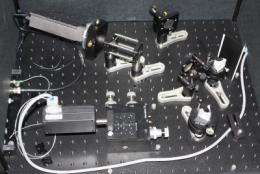Up-scale: Frequency converter enables ultra-high sensitivity infrared spectrometry

In what may prove to be a major development for scientists in fields ranging from forensics to quantum communications, researchers at the National Institute of Standards and Technology have developed a new, highly sensitive, low-cost technique for measuring light in the near-infrared range.
The technique can measure the spectrum of the specific wavelengths of near infrared light used widely in telecommunications as well as the very weak infrared light at single-photon levels given off by fragile biomaterials and nanomaterials. They described their results in a recent issue of Optics Express.
A single photon detector is the key device needed to build highly sensitive instruments for measuring spectra. For the past 30 years, scientists have made steady progress increasing the efficiency and sensitivity of visible and ultraviolet photon detectors while methods for detecting elusive single photons in the near-infrared (NIR) range have faltered. The methods presently in use are too static-laden, inefficient and slow, or depend on superconducting detectors, which require expensive, low-temperature operating environments. The NIST group, Lijun Ma, Oliver Slattery and Xiao Tang, wanted to develop a way to use existing detectors such as avalanche photodiode detectors (APD), which work very well for detecting visible light and are widely used, but are ineffective for the detection of NIR.
Their approach was to adapt a technique developed two years ago at NIST for quantum cryptography that “up converts” photons at one frequency to a higher frequency. The technique promotes the infrared photons up to the visible range using a strong, tunable laser. During the frequency conversion process, the narrow-band pump laser scans the infrared signal photons and converts only those that have the desired polarization and wavelength to visible light. Once converted to visible light, the signal photons are easily detected by commercially available APDs. According to Tang, the new system enables the measurement of spectra with sensitivity of more than 1,000 times that of common commercial optical spectral instruments.
“Our key achievement here was to reduce the noise, but our success would not have been possible without the many years of work by others in this field,” says Tang. “We hope that our discovery will open doors for researchers studying diseases, pharmaceuticals, secure communications and even solving crimes. We are very excited to make this technology available to the larger scientific community.”
More information: L. Ma, O. Slattery and X. Tang. Experimental study of high sensitivity infrared spectrometer with waveguide-based up-conversion detector. Optics Express. Vol. 17, No. 16. Aug. 3, 2009.
Source: National Institute of Standards and Technology (news : web)


















